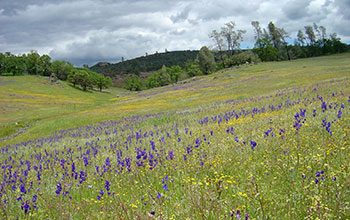Multimedia Gallery
Serpentine grassland
Serpentine grassland at a study site at the Donald and Sylvia McLaughlin Natural Reserve, with purple larkspur (Delphinium variegatum) and yellow goldfields (Lasthenia californica). The reserve is one of few sites in California that protects unusual serpentine habitats.
More about this image
Chemically hostile to most plants, serpentine deposits cover one third of the Donald and Sylvia McLaughlin Natural Reserve, creating islands that support rare and endemic plants that have adapted to these harsh soils and numerous associated endemic insects. Where there are non-serpentine soils, the vegetation shifts suddenly to more typical coast range habitats, including riparian woodland, blue oak woodland and savannah, grassland, and chaparral.
Researchers at the University of California (UC), Davis, which manages the reserve, received a National Science Foundation (NSF) Rapid Response Research (RAPID) grant (DEB 14-39246) to study the affects from the drought in California, which has reached record-setting severity--2013 had the lowest precipitation ever recorded in a calendar year. NSF awards RAPID grants for proposals having a severe urgency with regard to the availability of, or access to, data, facilities or specialized equipment, including quick response research on natural and other disasters. For the study, the researchers will seek to find which plant species and plant communities are most vulnerable to severe drought and which ones are more resistant to it.
The researchers will build on data gathered from five study sites across California, including at the reserve, that were used in a previous study. The previous studies examined how water availability affected plant communities using either experimental water additions, comparisons of wetter and drier years, or comparisons of geographic locations with differing amounts of rainfall. Each of these studies provided evidence about which characteristics of plant species and communities make them more or less sensitive to water availability. Using data collected in 2014, the same plant communities previously studied will be compared after versus before the drought, allowing the study to document which species and communities have changed the most in response to the drought.
You can learn more about the reserve Here. (Date image taken: 2013; date originally posted to NSF Multimedia Gallery: Nov. 3, 2015)
Credit: Catherine E. Koehler, McLaughlin UC Reserve
See other images like this on your iPhone or iPad download NSF Science Zone on the Apple App Store.
Images and other media in the National Science Foundation Multimedia Gallery are available for use in print and electronic material by NSF employees, members of the media, university staff, teachers and the general public. All media in the gallery are intended for personal, educational and nonprofit/non-commercial use only.
Images credited to the National Science Foundation, a federal agency, are in the public domain. The images were created by employees of the United States Government as part of their official duties or prepared by contractors as "works for hire" for NSF. You may freely use NSF-credited images and, at your discretion, credit NSF with a "Courtesy: National Science Foundation" notation.
Additional information about general usage can be found in Conditions.
Also Available:
Download the high-resolution JPG version of the image. (4.2 MB)
Use your mouse to right-click (Mac users may need to Ctrl-click) the link above and choose the option that will save the file or target to your computer.

